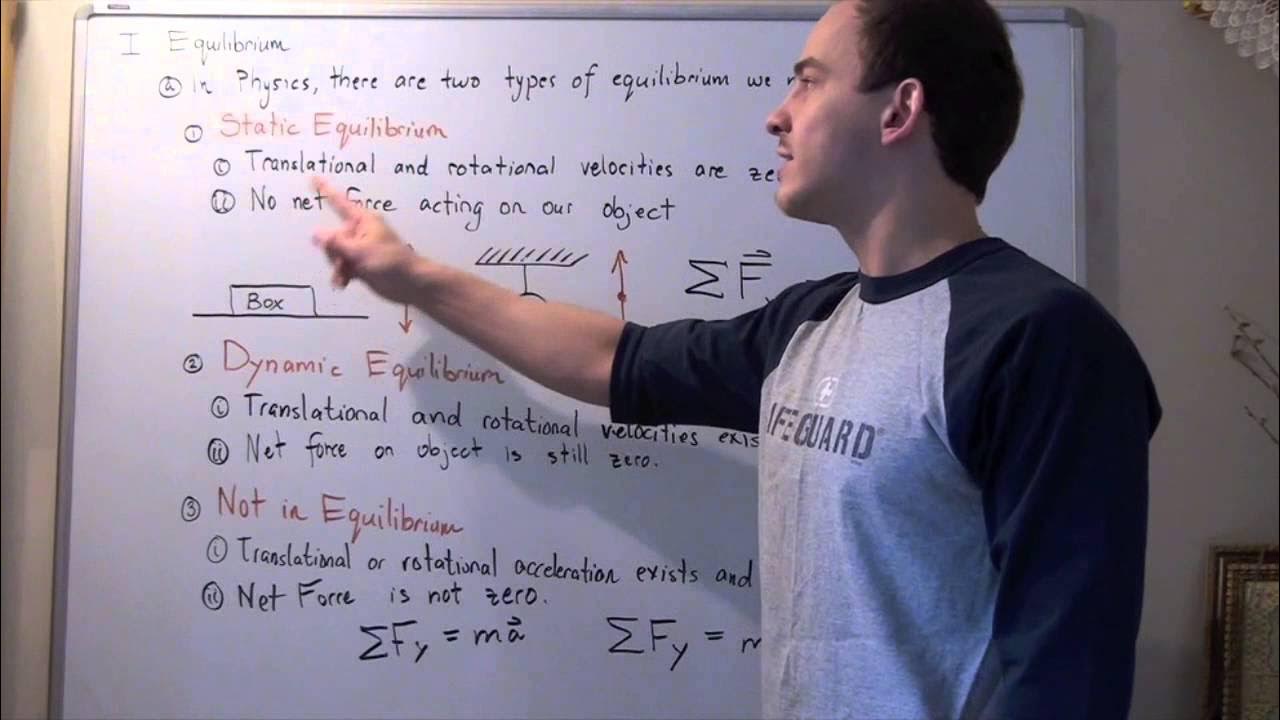Force | Free Body Diagrams | Physics | Don't Memorise
TLDRThis script provides a detailed explanation of how to draw free body diagrams for different physical situations involving forces. It begins with a box resting on a table, illustrating the balance between gravitational force and the normal force resulting in zero net force. The second scenario introduces a rightward force causing the box to accelerate, indicating an imbalance in forces due to the applied force being greater than the frictional force. The third situation describes a box moving at a constant velocity, where the applied force and frictional force are equal, maintaining zero net force. The fourth situation involves a skydiver falling at a constant velocity, where air resistance balances the force of gravity. Finally, the fifth scenario depicts a free-falling object where gravity exceeds air resistance, causing acceleration. The script emphasizes the importance of understanding the relationship between forces and their effects on motion.
Takeaways
- 📐 **Free Body Diagrams**: They are diagrams that show all the forces acting on an object.
- 🔵 **Gravity**: The force of gravity always acts downward on an object.
- 🔴 **Normal Force**: This force acts upward and is equal in magnitude to the force of gravity when an object is at rest on a surface.
- ⚖️ **Balanced Forces**: When the forces acting on an object are equal and opposite, the object remains at rest, and the net force is zero.
- ➡️ **Rightward Force**: An applied force in a specific direction (rightward in the second situation) causes the object to accelerate in that direction.
- 🔄 **Unbalanced Forces**: When forces are unbalanced, as indicated by acceleration, the object's velocity changes.
- 🚫 **Friction**: Friction acts in the opposite direction of motion and can be less than the applied force, causing the object to accelerate.
- 🏃 **Constant Velocity**: When an object moves at a constant velocity, the forces acting on it are balanced, and the net force is zero.
- 🌐 **Air Resistance**: In the context of skydiving, air resistance is the upward force that balances the downward force of gravity at constant velocity.
- 💥 **Free Falling**: When an object is in free fall, the force of gravity is greater than the air resistance, resulting in acceleration.
- 🔬 **Understanding Forces**: The script provides a fundamental understanding of how different forces interact and affect the motion of objects.
Q & A
What is the significance of the horizontal line in the first situation?
-The horizontal line represents the top of the table, which is the surface on which the box is placed.
How does the force of gravity affect the box in the first situation?
-The force of gravity acts downwards on the box, pulling it towards the Earth.
What is the normal force and how does it relate to the force of gravity in the first situation?
-The normal force is the upward force exerted by the table on the box. It is equal and opposite to the force of gravity, which is why the box does not move.
Why are the arrows representing forces in the first situation the same size?
-The arrows are the same size because the forces are balanced, resulting in a net force of zero, which keeps the box at rest.
In the second situation, why is there a rightward force acting on the box?
-The rightward force is an applied force that causes the box to accelerate across the table, indicating that the forces on the box are unbalanced.
How does the presence of acceleration in the second situation affect the forces acting on the box?
-Acceleration indicates that the velocity of the box is changing, which implies that the forces are unbalanced, with the applied force being greater than the frictional force.
What force acts in the opposite direction to the applied force in the second situation?
-The force of friction acts towards the left, opposite to the applied force that is causing the box to move to the right.
In the third situation, why are the applied force and frictional force depicted as the same size?
-In the third situation, the applied force and frictional force are of the same magnitude because the box is moving at a constant velocity, indicating that the net force is zero.
What is the role of air resistance in the fourth situation involving the skydiver?
-Air resistance is the force that opposes the motion of the skydiver and is equal in magnitude to the force of gravity, resulting in a constant velocity fall.
Why is there no normal force acting on the skydiver in the fourth situation?
-There is no normal force because the skydiver is not in contact with a surface like a table or ground, and thus there is no surface pushing back against the skydiver.
In the fifth situation, why is the gravitational force greater than the air resistance force?
-The gravitational force is greater than the air resistance force in the fifth situation because the object is in free fall and accelerating, indicating an unbalanced force.
What can be inferred about the forces acting on an object when it is moving at a constant velocity?
-When an object moves at a constant velocity, it implies that the net force acting on the object is zero, meaning all the forces acting on it are balanced.
Outlines
📐 Introduction to Free Body Diagrams
The video begins with an introduction to free body diagrams, focusing on a box resting on a table. It explains the forces of gravity pulling the box downwards and the normal force pushing it upwards, resulting in a balanced state with a net force of zero. The video then encourages viewers to attempt drawing free body diagrams for other scenarios, emphasizing the importance of understanding forces and acceleration.
🚀 Unbalanced Forces with Rightward Acceleration
The second paragraph discusses a scenario where a box on a table experiences a rightward force causing it to accelerate. The force of gravity is still present, but now there is an unbalanced force situation due to the applied rightward force. The video explains that the frictional force acting to the left is less than the applied force, leading to the box's acceleration. It highlights the significance of acceleration as an indicator of unbalanced forces.
🏎 Constant Velocity and Balanced Forces
The third situation described involves a box moving at a constant velocity to the right. The video explains that the gravitational and normal forces remain unchanged, but the applied force and frictional force are now equal in magnitude, maintaining a net force of zero. This balance allows the box to continue moving at a constant velocity, assuming no air resistance is considered.
🪂 Skydiver's Forces at Constant Velocity
In the fourth scenario, the video shifts focus to a skydiver in free fall. Unlike the box on a table, the skydiver does not experience a normal force due to the absence of a surface. The force of gravity is counteracted by air resistance, which is equal in magnitude, resulting in a constant velocity fall. This situation illustrates how balanced forces can result in a non-zero velocity.
💥 Free Falling with Unbalanced Forces
The final paragraph addresses a free-falling object, where the force of gravity exceeds air resistance, leading to acceleration. This situation demonstrates that when forces are unbalanced, acceleration occurs, and the object's velocity changes over time. The video concludes by encouraging viewers to explore more about the basics of forces through additional content.
Mindmap
Keywords
💡Free Body Diagram
💡Gravity
💡Normal Force
💡Friction
💡Acceleration
💡Applied Force
💡Constant Velocity
💡Air Resistance
💡Net Force
💡Balanced Forces
💡Unbalanced Forces
Highlights
Free body diagrams are used to illustrate all the forces acting on an object.
Gravity acts downwards, and the normal force acts upwards when an object is on a table.
Balanced forces result in no movement and a net force of zero.
When forces are unbalanced, as indicated by acceleration, the object moves.
The size of the arrows in a free body diagram represents the magnitude of the forces.
In the second situation, a rightward force causes the box to accelerate, implying unbalanced forces.
Friction acts in the opposite direction to the applied force when the box is moving.
The magnitude of the applied force is greater than friction when the box accelerates to the right.
In the third situation, the box moves at a constant velocity, indicating balanced forces.
Applied force and frictional force are equal in magnitude for constant velocity motion.
Air resistance is considered in the fourth situation involving a skydiver.
The absence of normal force in free-fall is compensated by air resistance.
Constant velocity implies that the force of gravity and air resistance are equal in magnitude.
In the fifth situation, the gravitational force exceeds air resistance during free-fall, causing acceleration.
Understanding the basics of forces is crucial for analyzing motion.
The video provides a comprehensive guide on how to draw and interpret free body diagrams.
The importance of considering acceleration and net force in analyzing an object's motion is emphasized.
The video encourages viewers to practice drawing free body diagrams for different situations.
Transcripts
5.0 / 5 (0 votes)
Thanks for rating:





